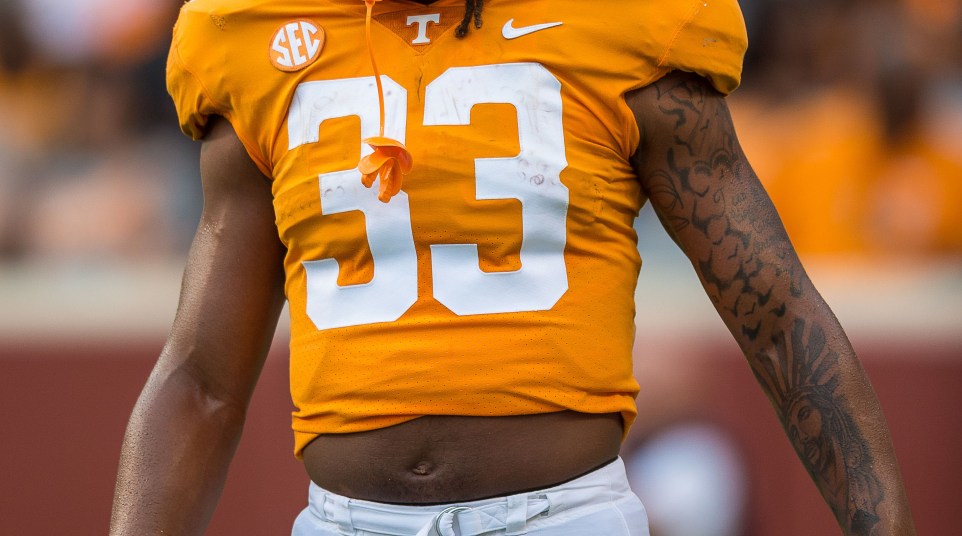
Tennessee's no-name defense exceeding all expectations halfway through 2021
Water bottles, beer cans, vape pins, oh my!!!
While the foolish actions of a couple hundred fans chewed up all the postgame headlines following Tennessee’s 31-26 loss to No. 13 Ole Miss, something that happened during the game is actually worth noting moving forward: The Vols can play a little defense in 2021.
The Rebels managed to run over 100 snaps in the win, but Lane Kiffin’s dynamic offense averaged just 5.0 yards per play (its 2nd-lowest total of the season) and only scored 7 points after halftime. The real Saturday scaries so many Vols fans were worried about this weekend? Well, through 7 games, Tim Banks’ cobbled-unit appears to have calmed those fears.
We’ll find out the next few weeks against No. 4 Alabama and No. 1 Georgia if Tennessee’s defense is only ‘OK’ or actually legit, but considering the current makeup of the roster, a group that was stripped to the studs has massively exceeded expectations.
“We were probably the thinnest football team in America when we started,” coach Josh Heupel said following Saturday’s game.
“But the fight and competitive spirit inside of our locker room, the want to play for the guy next to you because you love him, and you’re willing to do anything. We are developing and growing the right way.”
With “worse players” and a less acclaimed staff, the Vols are a markedly better defense in 2021 compared to 2020 — in practically every category.
Tennessee's defense was stripped to the studs this offseason, but through 7 games:
The Vols have more TFLs & INTs vs. all of 2020. Just 1 less sack. They're better vs. run and pass. They're better on 3rd downs.
Tim Banks' no-name unit has exceeded all preseason expectations.
— Jesse Simonton (@JesseReSimonton) October 18, 2021
Under former head coach Jeremy Pruitt and coordinator Derek Ansley last season, the Vols allowed 5.83 yards per play. They had a solid run defense (3.68 yards per rush) paired with a leaky secondary (8.5 yards per attempt allowed). They were mostly immune to havoc (just 20 sacks) and forced few turnovers (10 total in 10 games).
Yet despite a roster pilloried by the transfer portal — UT had to replace its top tackler (now Alabama linebacker Henry To’o To’o), 2nd-best linebacker (now Michigan State linebacker Quavaris Crouch), top 2 pass rushers (Arkansas State defensive end Kivon Bennett and Miami edge Deandre Johnson), its No. 1 cornerback (Bryce Thompson) and other notable contributors this offseason — Banks has produced a competitive, no-name unit.
Most, including yours truly, thought Tennessee would have one of the worst defenses in the SEC this fall, but in a simpler scheme, the Vols are thinking less and playing fast. And it’s working.
Tennessee leads the SEC in tackles for loss (62). It has more interceptions (8 to 5) through than it did all of last season. The Vols are stouter against the run (3.54 yards per carry) and pass (6.3 yards per attempt). They’re middling on 3rd downs, but they’re certainly better in that key area than they were a year ago (40.7% opponent conversion rate compared to 47.9%).
Under Banks’ stewardship, enigmatic junior inside linebacker Jeremy Banks has fulfilled his promise as a high-upside recruit, leading the team in tackles for loss (9.0) and sacks (4.5). Veteran defensive backs Theo Jackson and Alontae Taylor, both of whom had way too many up-and-down showings under the previous staff, have developed into steady, consistent performers.
Perhaps most impressively, Tennessee’s new staff has found useful ways to utilize the tools it has to work with. Linebackers Solon Page III and Aaron Beasley were deemed ill-equipped (i.e.: too small, not good enough) to play in Pruitt’s 3-4 scheme, but their speed has worked just fine in Banks’ hybrid scheme. The first-year coordinator has also found useful ways to get guys like defensive lineman Ja’Quain Blakely — a super-senior with 15 career total tackles entering 2021 who already has 20 tackles and 4.0 for loss this fall — and outside linebacker Roman Harrison more involved.
No one is surprised that Heupel and his new staff has produced an offense capable of fireworks and fun. The Air Raid works, especially against bad defenses (see: Pitt, South Carolina and Mizzou), but the defensive progress in Year 1 is something few — if anyone — foresaw. The road is rough upcoming facing Bryce Young & Co., but if Banks’ unit can play well overall the rest of the season, then Tennessee’s climb back up the SEC East hierarchy doesn’t look nearly as steep as it did 2 months ago.
